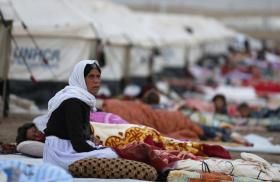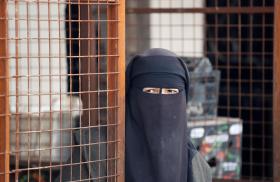Part of a series: Counterterrorism Lecture Series
or see Part 1: U.S. Efforts against Terrorism Financing: A View from the Private Sector
An expert look at the changing face of the global jihadist threat.
On February 10, 2009, Assaf Moghadam, Farhad Khosrokhavar, and Matthew Levitt addressed a special Policy Forum luncheon hosted by The Washington Institute's Stein Program on Counterterrorism and Intelligence. The speakers discussed al-Qaeda today and the changing face of the global jihadist threat. Dr. Moghadam is assistant professor and senior associate at the U.S. Military Academy's Combating Terrorism Center at West Point. Dr. Khosrokhavar is a professor of sociology at Ecole des Hautes Etudes en Sciences Sociales in Paris and is currently a visiting professor in Harvard University's Islamic Legal Studies Program. Dr. Levitt is a senior fellow and director of the Stein Program on Counterterrorism and Intelligence at the Institute. The following is a rapporteur's summary of their remarks.
Assaf Moghadam
One of al-Qaeda's main goals is to drive a wedge between the United States and its allies. A politically sophisticated terrorist organization, it will attempt to achieve this goal by widening its audience and broadening its appeal. The key for al-Qaeda will be to build local alliances in different regions, both with prominent and with little-known groups. Al-Qaeda will likely be careful in this task, shying away from forming associations with groups such as al-Qaeda in Iraq, whose behavior could reflect badly on the organization. On balance, however, these alliances help al-Qaeda expand its reach, become more resilient, and multiply its forces.
An important trend relates to al-Qaeda's structure. In the coming years, al-Qaeda will be a multipolar, less-unified, global entity that is not centered on a single region. Although the Afghan-Pakistan region will probably remain the central hub, al-Qaeda's presence has replicated in four or five regional hubs that have adopted its tactics of suicide attacks and the use of the internet to spread propaganda. An implication of this trend is that future attacks are likely to occur in or around these regions. But barring any surprises, such as the arrest or death of Usama bin Laden, al-Qaeda's central leadership will continue to plan attacks worldwide. Attacks by homegrown, al-Qaeda-inspired groups, are likely to rise, although not in the United States, and the successful ones will be very lethal.
Al-Qaeda still enjoys certain strengths that will force the United States to contend with it for the foreseeable future. The argument that the United States is waging a war against Islam will continue to resonate as long as U.S. troops remain in Iraq and Afghanistan. Al-Qaeda has increased its appeal at the local level by putting local and national grievances in a transnational framework. Its beliefs are the "ideology du jour" at a time when other ideologies (except for nationalism) are fading. The terrorist group has also strengthened since it regrouped in the Afghan-Pakistan tribal region.
Al-Qaeda, however, faces challenges. Several Islamist groups in Pakistan and the United Kingdom have criticized the group, and its tactics have been condemned in public protests. In addition, Tehran's defiance of the West and Hizballah's military prowess challenge al-Qaeda's assertion that it represents the vanguard of the Muslim world.
The more severe setback to al-Qaeda is ideological. Prominent Saudi scholars have disavowed the group, citing its unjustifiable killing of large numbers of Muslim civilians. Emphasizing the al-Qaeda's actions as detrimental to the Muslim cause significantly weakens it: the group would be more successful in attracting adherents if it managed to shift its focus to airing grievances against the United States.
Farhad Khosrokhavar
To understand jihadism, one must differentiate between the Muslim communities in the Middle East and the Muslim communities in Europe. Most people who join jihadist movements in Europe are culturally uprooted; they feel as though they are downtrodden, second-class citizens and are aggrieved by their treatment in inhospitable societies. People affiliated with these extremist groups feel totally victimized, which is a main ingredient of radicalization. In the European context, the radicalization of young Muslim men precedes jihadism. These youngsters have no history of being pious Muslims, and most of them know little or nothing about Islam.
In contrast, in the Middle East, jihadization and radicalization are more closely intertwined. Jihadists in the Middle East are from higher social classes, and because they have a much deeper understanding of Islam, religious figures do not simplify material for them as they do for Muslims in Europe. Other differences between the two jihadist worlds are that in Europe Jihadists often become radicalized in institutions, such as prisons, and converts become radicalized to prove their allegiance to their newfound religion, neither of which is true in the Middle East.
In recent years, jihadist intellectuals have combined action and theory, and have been successful at presenting a systematic and effective critique of democracy. For them, democracy is not a system of governance, but an ideology associated with Christianity. Their analysis combines victimization and humiliation with ideological tenets that rationalize and legitimize using violence.
We need to support Muslim reformists, since they believe that Islam and democracy can coexist. We need religious institutions in the Middle East that promote a way of governing society with a pluralistic system.
Matthew Levitt
Although the United States has made tangible progress in combating terrorism, the threat posed by global jihadist terrorists remains serious. Terrorism is an ever-evolving problem. In 2008, al-Qaeda managed to gain strength and improve its capability by deepening its alliances in the tribal areas of Pakistan, replenishing its cadre of midlevel lieutenants, developing detailed succession plans, and identifying and training Western operatives.
The global counterterrorism effort has seen areas of success: al-Qaeda's Saudi branch had been largely defeated and great progress has been made in Southeast Asia. Al-Qaeda has also had to contend with the growing number of voices rising to challenge the organization. Perhaps most importantly, these critics have included a number of al-Qaeda's foremost supporters. It is projected that al-Qaeda's appeal will continue to diminish.
While the long-term prospects for terrorist groups like al-Qaeda may not be promising, these groups still pose an immediate conventional threat and remain intent on acquiring weapons of mass destruction (WMD). While senior U.S. officials are clearly focused on the high-end threat, they are also concerned about the threat of low-end attacks in the United States. Terrorist groups are also increasingly engaging in criminal activities, and the growing links between terrorist groups and the criminal world are rendering them not only more complicated but also more dangerous.
Budding local terrorist cells are increasingly self-funded; in contrast, prior to September 11 al-Qaeda's core funded terrorist cells and plots directly. Some of these cells have connections to al-Qaeda's senior leadership but are independently and locally funded, while others operate on their own in "leaderless" communities. As the Obama administration's counterterrorism team assesses the terrorist threat today, they will find that while much has been accomplished, much still needs to be done. Global jihadist terrorists remain intent on carrying out acts of spectacular violence, targeting the United States and its allies. And although terrorists do not appear to have the capability to carry out a WMD attack today, they remain committed to that goal.
A successful counterterrorism campaign will constrict the operating environment and disrupt activity being plotted today, and counter the ideology of radical extremism to prevent plots from being planned tomorrow.
This rapporteur's summary was prepared by Ahmed Ali, a research assistant at The Washington Institute.
Policy #1477






